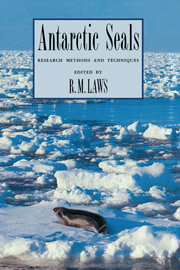Book contents
- Frontmatter
- Contents
- List of contributors
- Preface
- Introduction
- 1 Identification of species
- 2 Estimation of population sizes
- 3 Immobilization and capture
- 4 Marking techniques
- 5 Telemetry and electronic technology
- 6 Behaviour
- 7 Killing methods
- 8 Morphometrics, specimen collection and preservation
- 9 Genetic-based studies for stock separation
- 10 Collection of material for the determination of organochlorine and heavy metal levels
- 11 Age determination
- 12 Reproduction
- 13 Diet
- 14 Bioenergetics
- 15 Development of technology and research needs
- 16 Appendices
- Index
2 - Estimation of population sizes
Published online by Cambridge University Press: 05 February 2010
- Frontmatter
- Contents
- List of contributors
- Preface
- Introduction
- 1 Identification of species
- 2 Estimation of population sizes
- 3 Immobilization and capture
- 4 Marking techniques
- 5 Telemetry and electronic technology
- 6 Behaviour
- 7 Killing methods
- 8 Morphometrics, specimen collection and preservation
- 9 Genetic-based studies for stock separation
- 10 Collection of material for the determination of organochlorine and heavy metal levels
- 11 Age determination
- 12 Reproduction
- 13 Diet
- 14 Bioenergetics
- 15 Development of technology and research needs
- 16 Appendices
- Index
Summary
Introduction
This chapter provides a review of the methods which are currently available for estimating the size of Antarctic seal populations. Such estimates have a wide range of potential uses, ranging from the evaluation of the status of a species as part of a management or conservation plan, to the use of the species' abundance as an indicator of prey availability. However, there is no one estimation technique which is suitable for all purposes. The choice of a suitable technique will depend on the use which will be made of the results, the logistic constraints imposed on the survey team, and the basic biology of the species involved. The following sections have been designed to provide sufficient information about the available techniques to allow a choice between them to be made. They provide some advice on the general direction for subsequent analysis of results, but calculations of the precision and accuracy of the resulting estimates must be left to individual investigators. However, these latter calculations are essential to any estimate of abundance and anyone contemplating making such estimates should ensure that they will have access to adequate statistical advice during the design of a survey and the subsequent analysis of results.
Basic considerations
First it must be recognized that it is practically impossible to make a total census of all the age-classes in any seal population. Seals partition their time among areas such as beneath the surface of the sea, hauled out on land or ice, or at sea; the time spent in these habitats varies depending on sex, age and season.
- Type
- Chapter
- Information
- Antarctic SealsResearch Methods and Techniques, pp. 29 - 45Publisher: Cambridge University PressPrint publication year: 1993
- 7
- Cited by



